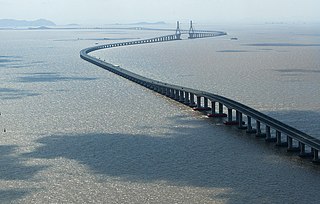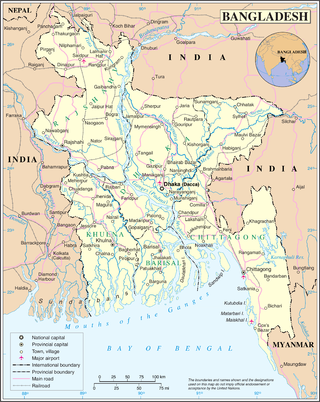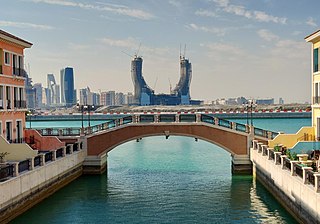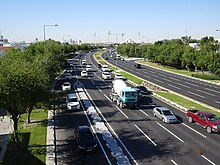
Transport in India consists of transport by land, water and air. Road transport is the primary mode of transport for most Indian citizens, and India's road transport systems are among the most heavily used in the world.
This article is about transport in Oman.

Transport in China has experienced major growth and expansion in recent years. Although China's transport system comprises a vast network of transport nodes across its huge territory, the nodes tend to concentrate in the more economically developed coastal areas and inland cities along major rivers. The physical state and comprehensiveness of China's transport infrastructure tend to vary widely by geography. While remote, rural areas still largely depend on non-mechanized means of transport, urban areas boast a wide variety of modern options, including a maglev system connecting the city center of Shanghai with Shanghai Pudong International Airport. Airports, roads, and railway construction will provide a massive employment boost in China over the next decade.

Transport in Pakistan is extensive and varied. In recent years, new national highways have been built, with the addition of motorways which have improved trade and logistics within the country. Pakistan's rail network is also undergoing expansion in recent years. Airports and seaports have been built with the addition of foreign and domestic funding. Transportation challenges in Pakistan are escalating due to poor planning, inadequate governance, and corrupt practices. Consequently, the nation are grappling with a significant crisis in their transportation systems.

Transportation in the Philippines covers the transportation methods within this archipelagic nation of over 7,500 islands. From a previously underdeveloped state of transportation, the government of the Philippines has been improving transportation through various direct infrastructure projects, and these include an increase in air, sea, road, and rail transportation and transport hubs.

Transport in Saudi Arabia is facilitated through a relatively young system of roads, railways and seaways. Most of the network started construction after the discovery of oil in the Eastern Province in 1952, with the notable exception of Highway 40, which was built to connect the capital Riyadh to the economically productive Eastern Province, and later to the Islamic holy city of Mecca and the port city of Jeddah. With the economic growth of the 1970s, the Kingdom of Saudi Arabia has initiated many infrastructure development projects across the country, and the extensive development of the transportation network has followed suit in support of various economic developments.

Transportation in Singapore is predominantly land-based, with a comprehensive network of roads making many parts of the city-state, including islands such as Sentosa and Jurong Island, accessible. The road network is complemented by a robust rail system consisting of the Mass Rapid Transit (MRT) and the Light Rail Transit (LRT), which cover the length and width of Singapore and serve a few neighbourhoods respectively. The main island of Singapore is also connected to other islands via ferryboat services. Furthermore, the city-state maintains strong international connections through two bridges linking it to Malaysia – the Causeway and the Second Link – and the Singapore Changi Airport, a major aviation hub in Asia.

Since Bangladesh's independence in 1971, the transportation sector has grown rapidly and transportation medium on land and rivers have begun to develop. Air travel came into existence later. Though Bangladesh has greatly evolved in the transportation sector, it still has many flaws which hamper the development of other economic and social sectors. Transportation has evolved in mostly land vehicles but it still needs improvement in safety standards, which endangers the life of civilians.

Lusail is the second-largest city in Qatar after Doha, and the economic capital of Qatar, located on the coast, in the southern part of the municipality of Al Daayen. Lusail lies about 23 kilometres (14 mi) north of the Doha city centre, just north of the West Bay Lagoon, on over 38 square kilometres (15 sq mi) and will eventually have the infrastructure to accommodate 450,000 people. Of these 450,000 people, it is estimated that there will be 250,000 or fewer residents, 190,000 office workers and 60,000 retail workers.

Delhi has significant reliance on its transport infrastructure. The city has developed a highly efficient public transport system with the introduction of the Delhi Metro, which is undergoing a rapid modernization and expansion since 2006. There are 16.6 million registered vehicles in the city as of 30 June 2014, which is the highest in the world among all cities, most of which do not follow any pollution emission norm, while the Delhi metropolitan region has 11.2 million vehicles. Delhi and NCR lose nearly 42 crore man-hours every month while commuting between home and office through public transport, due to the traffic congestion. Therefore, serious efforts, including a number of transport infrastructure projects, are under way to encourage usage of public transport in the city.
Transport in Greater Kuala Lumpur includes a road network, a railway network, airports, and other modes of public transport. Greater Kuala Lumpur is conterminous with the Klang Valley, an urban conglomeration consisting of the city of Kuala Lumpur, as well as surrounding towns and cities in the state of Selangor. The Klang Valley has the country's largest airport, the Kuala Lumpur International Airport (KLIA), as well as the country's largest intermodal transport hub and railway station, Kuala Lumpur Sentral.
Since the early 2000s, Doha, the capital of Qatar has been undergoing an extensive expansion in its transportation network including the addition of new highways, the construction of a new airport, and the under-construction Doha metro. These projects are meant to keep up with the population's rapid growth, which has strained the country's current infrastructure.

Old Airport is an area of Doha, Qatar. The district is located close to the site of Doha's old international airport servicing Qatar before the construction of the Hamad International Airport. Running through the district is Al Matar Al Qadeem Street, around which many businesses and retailers cater to the residents of the area. The first mall constructed in Qatar is also located within the district, next to the congested Najma roundabout.

The transportation system in Metro Manila covers the road network, rail network, ferries, ports and airports located with the metropolitan Manila area. Road transportation in Metro Manila is diverse, composed of many types of private and public transport vehicles. These include taxis, buses, jeepneys, tricycles and pedicabs. In some areas, especially in Divisoria and large public markets, two-stroke motors are fitted in the pedicabs and are used for goods transport. Regardless of modernity, horse-drawn kalesas are still used in the streets of Binondo and Intramuros. Ridesharing services such as Grab also operate within in Metro Manila.

Al Daayen is a municipality in Qatar. Most of the urban landscape can be found in the southern zone of the municipality, particularly in the city of Lusail, while the northern and central sections are primarily rural. It is one of the fastest growing municipalities in Qatar due to its close proximity to the capital Doha.

The Doha Metro is a rapid transit system in the Doha Metropolitan Area of Qatar's capital city Doha, which became operational on 8 May 2019. It has three lines with an approximate overall length of 76 km (47 mi) and 37 stations. It is an integral component of the larger Qatar Rail network, which will include a long-distance rail for passengers and freight, linking Qatar to the GCC, and the Lusail LRT. Capable of reaching 100 km/h (62 mph), the Doha Metro has one of the fastest driverless trains in the world.
The Metro Manila Dream Plan, formally titled the Roadmap for Transport Infrastructure Development for Metro Manila and Its Surrounding Areas, refers to a 2014 integrated plan for improving the transport system in Metro Manila, Philippines, with the hope of turning it into a focal point for addressing Metro Manila's interlinked problems in the areas of transportation, land use, and environment.

The Doha Industrial Area is a district of Doha Municipality, Qatar. It was previously a part of the Al Rayyan Municipality, which now geographically separates it from the rest of Doha Municipality. The majority of the area's workers reside in the adjacent Labour City.

Qatar Railways Company, commonly known as Qatar Rail, is a state-owned railway company, responsible for rail transport in Qatar. It is owned and operated by the Government of Qatar. Established in 2011, the company is responsible for the design, construction, commissioning, operation and maintenance of the entire rail network and systems. It manages Qatar's rail network. On May 8, 2019, Qatar rail started the preview service of Doha Metro with 13 stations on the Red Line, starting from Al-Qassar station in the North to Al-Wakra station in the South. The three metro lines that form the current network became fully operational by September 2020.

Shenzhen has an extensive transport network, including various forms of land, water and air transport.



















